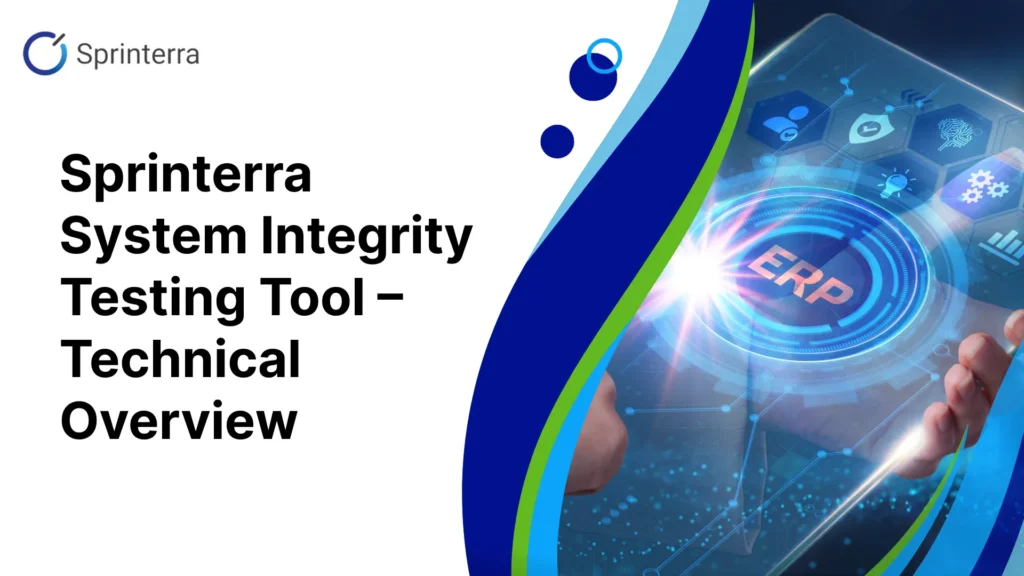
The Sprinterra System Integrity Testing Tool is designed to ensure the stability and reliability of Acumatica ERP environments before, during, and after upgrades or customization deployments.
It provides automated verification of Out-of-the-Box (OOB) functionality and custom extensions using a combination of Acumatica Test SDK, Continuous Integration (CI) automation, and an AI-powered diagnostic engine that interprets test outcomes and suggests resolutions.
This document describes the technical architecture, frameworks, and process workflow behind the tool.
At the heart of the solution is the Acumatica Test SDK — a .NET-based framework that provides programmatic access to Acumatica’s UI and business logic for end-to-end testing.
Sprinterra’s QA and engineering team have built a comprehensive suite of automated tests that validate:
Each test script is developed using:
The test suite is executed automatically within a CI/CD pipeline, typically configured in:
This architecture allows the tool to run across multiple Acumatica versions and configurations with minimal manual setup.
This component is currently in the Proof-of-Concept (POC) stage.
After each automated test run, all execution logs, screenshots, and test result files are collected and analyzed by Sprinterra’s AI agent.
This component uses a combination of:
The AI engine outputs a structured diagnostic report that includes:
Recommended corrective actions or configuration checks

The CI pipeline launches a dedicated Acumatica instance (either a sandbox or containerized environment).
Required configurations — such as company setup, feature enablement, and sample data — are deployed automatically via configuration scripts.
The Acumatica Test SDK test suite is triggered through a CI job.
Each test simulates user actions and verifies system behavior through API-level and UI-level validation.
Logs and screenshots are recorded in structured output directories (e.g., .trx, .xml, .json formats).
When the test run completes:
This component is currently in the Proof-of-Concept (POC) stage.
The AI agent ingests the logs and applies rule-based and statistical evaluation to detect:
The agent then generates a System Integrity Report, which includes:
The generated report is shared with QA and development teams via the project’s CI dashboard.
For client-facing visibility, summarized results can be exported as a PDF or web dashboard showing:
Area | Description |
Automation Framework | Built on Acumatica Test SDK, ensuring full compatibility with the platform’s UI and APIs. |
Scalability | Runs in any CI/CD environment (Azure DevOps, GitHub Actions, Jenkins) and supports multi-tenant testing. |
Intelligent Analysis | The AI agent provides actionable insights, reducing manual log review effort. |
Continuous Validation | Designed to run automatically during version upgrades, hotfix deployments, or customization releases. |
Extensibility | Supports addition of client-specific test cases to validate customizations alongside standard OOB coverage. |
+-----------------------------+
| CI/CD Orchestrator |
| (Azure DevOps / Jenkins) |
+--------------+--------------+
|
v
+---------------------------------------------+
| Automated Test Execution Layer |
| - Acumatica Test SDK + NUnit Framework |
| - PowerShell environment setup scripts |
| - Log & Screenshot capture |
+---------------------------------------------+
|
v
+---------------------------------------------+
| AI Diagnostic Engine |
| - NLP-based log parser |
| - Error classification & fix suggestions |
| - Report generation |
+---------------------------------------------+
|
v
+---------------------------------------------+
| System Integrity Dashboard |
| - Pass/Fail summaries |
| - Root cause insights |
| - Recommendations |
+---------------------------------------------+
With this automated testing and AI-driven diagnostics, Sprinterra’s System Integrity Testing Tool provides:
The Sprinterra System Integrity Testing Tool combines Acumatica’s native Test SDK with modern CI automation and AI intelligence to provide a next-generation approach to ERP quality assurance.
It allows Acumatica users and partners to maintain system integrity continuously, accelerate upgrade cycles, and minimize post-deployment risks — ensuring a smooth and predictable ERP experience.
Get the latest insights on exponential technologies delivered straight to you
It’s an automated testing solution for Acumatica ERP that verifies both standard and customized functionality. The tool ensures system stability before and after upgrades, minimizing risks of broken workflows or data inconsistencies caused by version updates or customization deployments.
It’s built on the Acumatica Test SDK using C# and NUnit, integrated into CI/CD platforms like Azure DevOps or GitHub Actions. An AI diagnostic engine analyzes logs and test results, classifying errors and recommending corrective actions to streamline QA and reduce manual debugging time.
Yes. The tool validates standard Acumatica processes such as Finance, Distribution, and CRM, while allowing client-specific test cases for custom extensions. This ensures full system coverage and stable performance after each upgrade or deployment.
Users gain continuous system validation, faster troubleshooting through AI-driven analysis, reduced manual QA effort, and smoother upgrade cycles. It helps maintain consistent functionality across updates and guarantees business stability without unexpected ERP issues.
It’s designed for use before, during, and after Acumatica upgrades or customization releases. Automated tests run in sandbox or CI/CD environments to confirm readiness, verify functionality, and deliver a comprehensive system integrity report for QA and development teams.